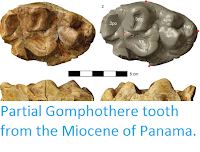The Indian Elephant, Elephas maximus, is the last surviving member of a genus that ranged from East Africa to Sulawesi in the Pliocene. Four members of this genus are known in the fossil record of India, Elephas maximus plus the Pliocene Elephas planifrons and Elephas hysudricus and the Pleistocene Elephas namadicus (sometimes placed in the genus Palaeoloxodon, along with the extinct European Straight-tusked Elephant). However there is also a large collection of Elephant remains collected from the Plio-Pleistocene Siwalik deposits of Jammu and Kashmir by the Geological Survey of India, many of which have never been described, making it possible that the full history of the group that is not understood.
In a paper published in the journal Vertebrata PalAsiatica on 1 December 2016, Som Nath Kundal, Gyan Bhadur and Sandeep Kumar of the Department of Geology of the University of Jammu describe a partial tooth assigned to the genus Elephas from the Early Pleistocene Siwalik deposits of Jammu and Kashmir.
The specimen comprises a single partial third molar with broken roots obtained from a mudstone horizon underlying a volcanic ash layer in the Nagrota Formation from a river cutting close to the village of Nangal, 15 km northwest of Samba city. The volcanic ash layer has been dated to 2.48 million years ago, making it Early Pleistocene in origin.
Left M3 of Elephas sp. from Nangal in Jammu and Kashmir. (A) Occlusal view; (B) labial view; (C) lingual view. Kundal et al. (2016).
Kundal et al. carried out a morphometric analysis (a tool used by palaeontologists, archaeologists,
anthropologists and forensic pathologists to analyse and compare
specimens) on the tooth, comparing it to the four Elephas species known from India, from which they conclude that the specimen falls within the range of Elephas planifrons, a species previously known from the Pliocene only (3.6 to 2.6 million years ago), extending the range of this species into the Early Pleistocene.
See also...
Follow Sciency Thoughts on Facebook.







